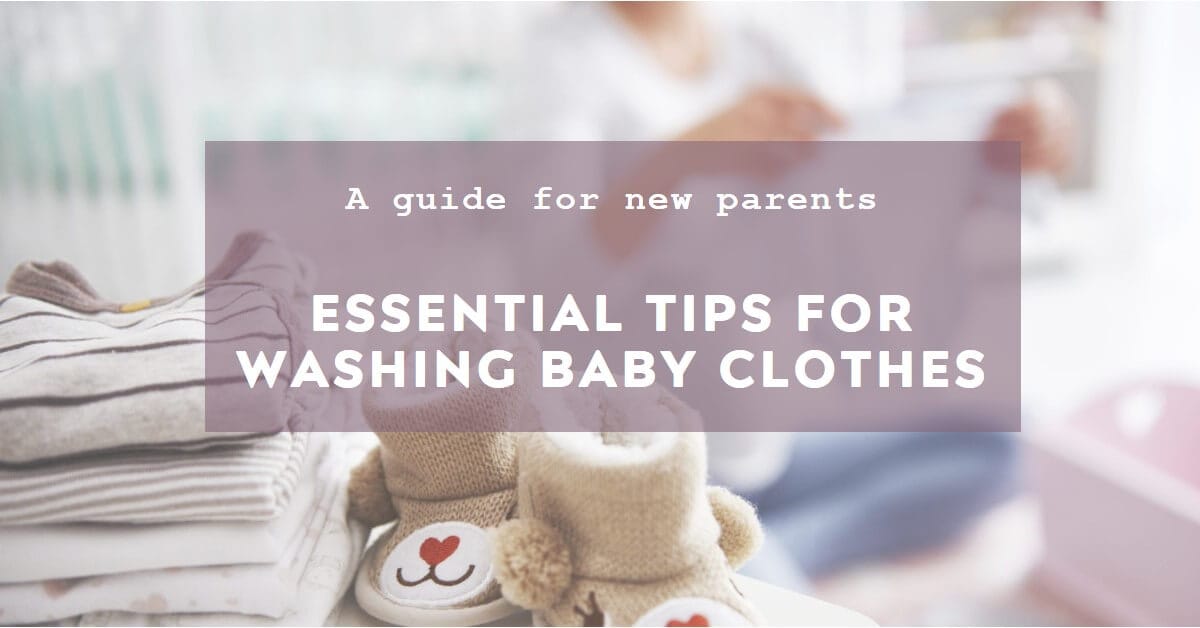Washing baby clothes can seem daunting at first, but it’s simpler than you might think. As a parent, I’ve learned that keeping my little one’s clothes clean and soft is essential for their comfort and health. To wash baby clothes, use a gentle, fragrance-free detergent and choose cool or cold water settings on your washing machine.
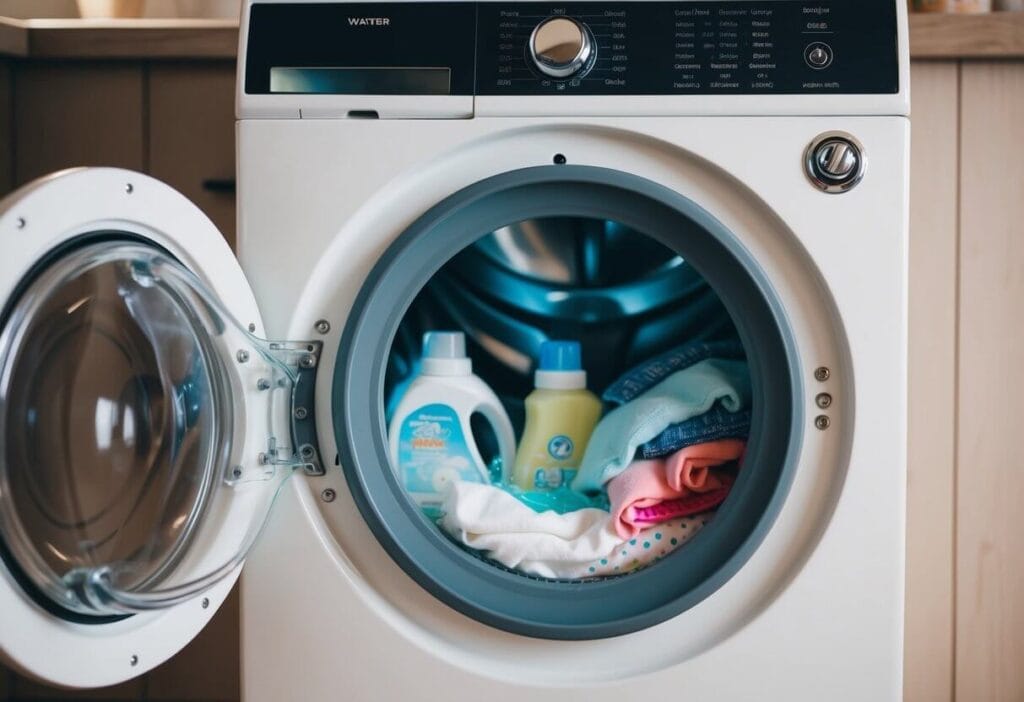
Sorting clothes by colour and fabric type is important before washing. I always separate whites from darks and set aside any items with special care instructions. For stubborn stains or clothes that have been in contact with poo or sick, I pre-treat them and wash at a higher temperature.
After washing, I either tumble dry on low heat or hang the clothes to air dry. This helps keep the fabrics soft and prevents shrinkage. By following these simple steps, I ensure my baby’s clothes stay clean, fresh, and gentle on their delicate skin.
On This Page
Key Takeaways
- Use gentle, fragrance-free detergent and cool water for washing baby clothes
- Sort clothes by colour and fabric type, pre-treating stains as needed
- Dry clothes on low heat or air dry to keep fabrics soft and prevent shrinkage
Preparing Baby Clothes for Washing
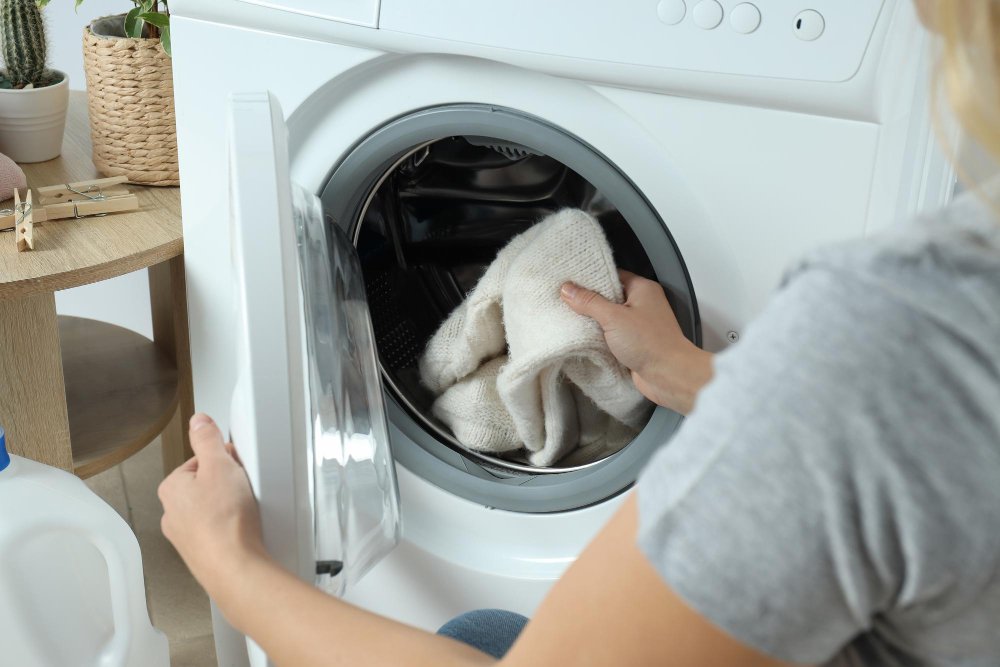
Getting baby clothes ready for washing involves a few key steps. These help ensure the clothes come out clean and well-cared for.
Sorting Laundry by Colour and Fabric Type
I always start by sorting baby clothes into piles. I separate whites from colours to prevent dye transfer. Light and dark colours go in different piles too.
Next, I group items by fabric type. Delicates like cotton knits need gentle washing. Tougher fabrics like denim can handle more agitation.
I also set aside any cloth nappies or clothes with poo stains. These need washing at a higher temperature.
For clothes marked ‘flame resistant’, I make a separate pile. These need special care to maintain their protective properties.
Checking Washing Instructions
Before washing, I carefully check the care labels on each item. Some baby clothes need hand washing or cold water only.
I look out for any ‘dry clean only’ tags. These items can’t go in the washing machine at all.
For new clothes, I always wash them before my baby wears them. This removes any leftover chemicals from manufacturing.
If I’m unsure about an item, I err on the side of caution. I use the gentlest wash cycle and coolest water temperature.
Pre-treating Stubborn Stains
Baby clothes often get messy. I tackle stains right away for best results.
For milk or spit-up stains, I rinse with cold water. Then I apply a bit of baby-safe stain remover.
Poo stains are trickier. I scrape off any solids first. Then I soak the item in cold water with a gentle enzyme cleaner.
For food stains, I dab with a mix of water and mild soap. I avoid rubbing, which can set the stain deeper into the fabric.
After pre-treating, I let stains sit for about 15 minutes before washing. This gives the stain remover time to work its magic.
Choosing the Right Detergent
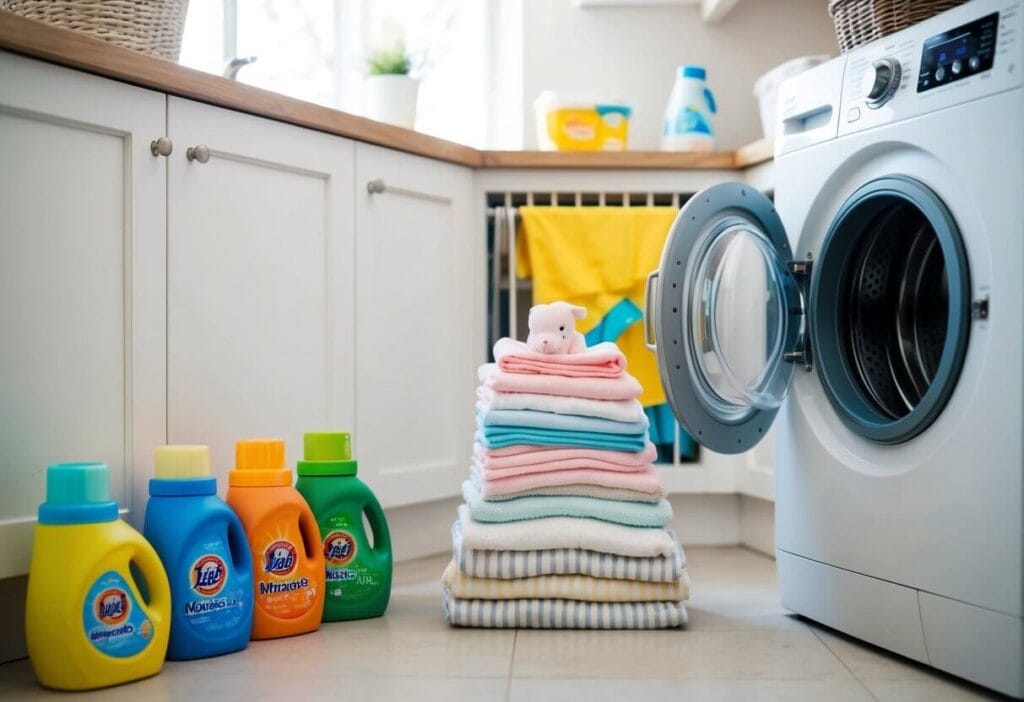
Picking the proper detergent is key for washing baby clothes. I’ll explain what to look for in baby-safe options and break down important ingredients to consider.
Selecting a Baby-Safe Detergent
When choosing a detergent for baby clothes, I look for gentle, fragrance-free formulas made for sensitive skin. Liquid detergents often rinse out more easily than powders. I avoid strong scents and dyes that might irritate delicate skin.
Many brands offer special baby laundry detergents. These tend to be milder than regular detergents. I make sure to check labels for terms like “hypoallergenic” or “for sensitive skin”.
For babies with eczema or allergies, I’m extra careful. I pick detergents free from common allergens. Sometimes, I’ll do a small test wash to check for any skin reactions.
Understanding Detergent Ingredients
I always read ingredient lists when picking baby detergents. I avoid harsh chemicals, optical brighteners, and strong fragrances.
Some key things I look out for:
- Enzymes: These help clean tough stains but can sometimes irritate skin
- Plant-based ingredients: Often gentler than synthetic ones
- Preservatives: Needed to keep the product stable, but some can cause reactions
I prefer detergents without added perfumes or dyes. These can linger on clothes and bother a baby’s skin.
If a baby has very sensitive skin, I might choose a detergent made just for babies. These often leave out more potential irritants than regular “sensitive” formulas.
Washing Process: Machine and Hand Wash
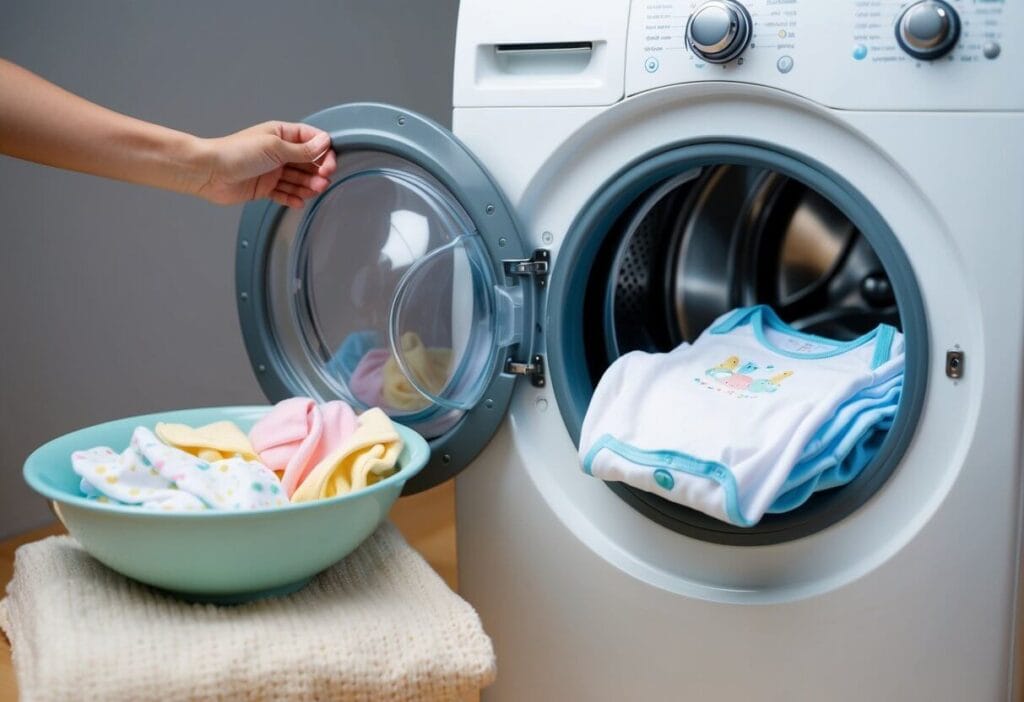
Washing baby clothes requires care and attention. I’ll explain how to use a washing machine and hand-wash delicate items to keep your little one’s clothes clean and soft.
Using the Washing Machine
I always start by checking the care labels on baby clothes. Most items can go in the machine on a gentle cycle. I empty the washer first to make sure no stray items get mixed in.
For the wash, I use cold water and a mild detergent made for babies. Hot water can set stains and damage fabric. I add clothes loosely to allow proper cleaning.
I run an extra rinse cycle to remove all soap. This helps prevent skin irritation. For cloth nappies, I do a pre-rinse cycle before the main wash.
After washing, I check for any remaining stains. If needed, I treat them before drying. I prefer to air-dry baby clothes when possible. It’s gentler on the fabric.
Hand-washing Delicate Items
Some baby items need hand-washing. I fill a basin with cool water and add a small amount of mild soap. I gently swish the clothes in the water, taking care not to rub or wring them.
For tough stains, I dab them with a soft cloth. I don’t scrub, as this can damage delicate fabrics. After washing, I rinse the items in clean, cool water until all soap is gone.
To dry, I gently squeeze out excess water. I never twist or wring the clothes. I lay them flat on a clean towel, reshaping as needed. Delicate items dry best away from direct heat or sunlight.
Drying and Caring for Baby Clothes
Proper drying and care keep baby clothes soft and long-lasting. I’ll cover the best methods to dry garments and prevent damage.
Air Drying Versus Tumble Drying
Air drying is often best for baby clothes. I hang items on a drying rack or clothesline away from direct sunlight. This method is gentle and helps clothes last longer.
For tumble drying, I use a low heat setting. I remove clothes while slightly damp to reduce wrinkles. Tumble drying is quicker but can cause more wear.
I always check care labels first. Some items need air drying only. I dry cloth nappies separately from other clothes.
Avoiding Shrinkage and Damage
To keep baby clothes in top shape, I take care when washing and drying. I turn clothes inside out to protect prints and fabrics.
I don’t use fabric softeners. They can irritate baby’s skin and reduce the absorbency of nappies.
I wash baby clothes separately from adult items. This stops harsh detergents or rough fabrics from touching baby’s clothes.
For delicate items, I use mesh bags in the wash. I button up cardigans and zip up jackets before washing to keep their shape.
Best Practices for Baby Clothes Longevity
Keeping baby clothes in good shape takes some care. I’ll share tips on storing clean clothes and regular upkeep to help them last longer.
Storing Clean Baby Clothes
I always fold baby clothes neatly to avoid wrinkles and creases. Drawer dividers help keep items sorted by size or type. For hanging clothes, I use padded hangers to prevent damage to delicate fabrics.
Airtight containers protect stored clothes from dust and pests. I add silica gel packets to absorb moisture and prevent mildew. Labelling boxes by size makes it easy to find what I need later.
To keep whites bright, I store them away from coloured items. This stops dye transfer that can dull whites over time.
Regular Maintenance Tips
I check clothes for stains before washing. For tough marks, I pre-treat with a mix of white vinegar and baking soda. This natural combo works well without harsh chemicals.
When washing, I turn clothes inside out to reduce wear. I skip fabric softener as it can irritate baby’s skin and make clothes less absorbent.
I wash whites separately in cool water to keep them bright. For extra whitening, I soak them in a mixture of water and lemon juice before washing.
I avoid using bleach on baby clothes. It’s harsh and can weaken fabrics over time. Instead, I use the sun’s natural bleaching power by hanging white items outside to dry when possible.
Frequently Asked Questions
How to wash new baby clothes for the first time?
Washing new baby clothes for the first time is crucial to remove any chemicals or dust from the manufacturing and packaging process. Here’s what you should do:
Step 1: Separate whites, colours, and delicates.
Step 2: Use a mild, baby-friendly detergent (non-bio is ideal).
Step 3: Wash at a low temperature (30-40°C) to protect fabrics and preserve softness.
Step 4: Rinse thoroughly to ensure all detergent is washed out.
Can you wash baby clothes in a regular washing machine?
Yes, you can wash baby clothes in a regular washing machine. Just make sure to:
1. Use a delicate cycle or a baby-specific setting, if available.
2. Opt for cool or warm water (30-40°C) to avoid damage to fabrics.
3. Choose a mild detergent to protect your baby’s sensitive skin.
What is best to wash baby clothes in?
The best option for washing baby clothes is a non-bio detergent that is free from harsh chemicals and dyes.
Non-bio detergents are designed to be gentler on sensitive skin because they lack enzymes that could cause irritation.
If your baby has particularly sensitive skin, consider hypoallergenic or fragrance-free detergents.
Do you use fabric softener when washing baby clothes?
It’s generally recommended not to use fabric softener on baby clothes, especially for newborns.
Fabric softeners can leave a residue that may irritate your baby’s skin, and they can reduce the absorbency of fabrics like muslins or towels.
Opt for dryer balls or line drying to keep clothes soft naturally.
What setting on washing machine for baby clothes?
For baby clothes, select a delicate or gentle cycle on your washing machine. This setting uses slower spin speeds and shorter wash times, helping to preserve the softness of the fabric.
A temperature of 30-40°C is usually sufficient to clean baby clothes effectively while protecting the material.
Do I need special detergent for baby clothes?
While you don’t necessarily need a detergent marketed specifically for babies, you should use a non-bio detergent that’s free from dyes, fragrances, and harsh chemicals.
These products are gentler on delicate skin and are less likely to cause irritation.
Is it OK not to wash new baby clothes?
It’s not recommended to skip washing new baby clothes. New clothes may have been treated with chemicals during manufacturing or could have picked up dust and dirt during packaging and shipping.
Washing them before the first wear ensures they’re clean and safe for your baby’s sensitive skin.
Do you have to use Fairy on baby clothes?
Fairy is a popular choice for washing baby clothes because it’s a non-bio detergent that’s gentle on skin. However, it’s not a requirement to use Fairy specifically.
Any non-bio, hypoallergenic detergent will work as long as it’s free from strong fragrances and harsh chemicals.
How do you prepare baby clothes for the washing machine?
Step 1: Check labels for any specific washing instructions.
Step 2: Fasten buttons, Velcro, and zippers to prevent snags.
Step 3: Remove any stains by pre-treating them with a baby-friendly stain remover.
Step 4: Sort clothes by colour and fabric type.
Step 5: Turn clothes inside out to protect delicate fabrics and prints.
Should I turn baby clothes inside out before washing?
Yes, turning baby clothes inside out before washing helps protect delicate fabrics, prints, and embellishments from wear and tear during the wash cycle.
This practice also reduces fading and preserves the softness of the material, ensuring that your baby’s clothes stay in top condition.

